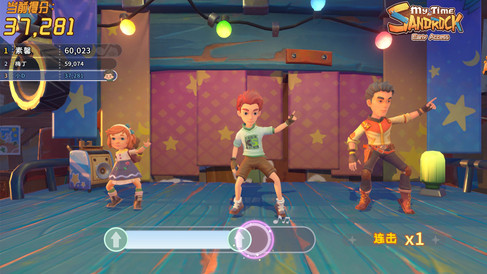Early Access Review: My Time at Sandrock
- L. Sahara McGirt
- May 24, 2022
- 4 min read
By: L. Sahara McGirt (DarthSagaSwag)

Developer: Pathea Games
Available on: PC (Steam Early Access, Epic Game Store)
Great news for anyone who played My Time at Portia; developer Pathea Games brings us yet another game in the My Time series: My Time at Sandrock. If you have never played My Time at Portia and enjoy games such as Harvest Moon, Rune Factory, Stardew Valley, etc., it's worth checking out. I've spent the last three weeks with My Time at Sandrock, and as with all next steps in a series of games, I want to know if the latest game is worth sinking time into.
Much like My Time at Portia, My Time at Sandrock has players taking on the role of a Builder. Builders craft and repair what the locals need, build up the town and their workshop as well as build up relationships with the locals. What's great about the My Time series is that most of what players craft and build visibly impacts the town and the characters held within.
My Time at Sandrock greatly improves what much of My Time at Portia introduced. Character customization is a little more robust with more options on hairstyles, eye colors, skin tones, etc. Further, the game has improved graphics while maintaining the stylism of My Time at Portia. In all frankness, the game has grown even more pleasing to look at. Even in its Alpha state, I could already see a great number of improvements graphically and artistically happening within the game.
My first week out with the game had me already pleased with much of what I saw, but what about what I was playing? Well, rest assured, My Time at Sandrock also improves much in mechanics and gameplay. To start with, the menus have improved. They're better organized, nicer to look at, and come with an improved skill tree menu. Assembly Station diagrams are easier to find and don't require flipping through a hundred pages to get to. Even researching new diagrams is easier as what diagrams players receive after giving the local researcher Qi discs is no longer randomized.

My Time at Sandrock also introduces some new elements to gameplay. While farming is mostly optional for much of the My Time series, My Time at Sandrock throws a new wrench into farming, crafting, and building: Water availability. Sandrock is aptly named as the town is set smack dab in the middle of a desert, and as such, water is in limited supply. Players have to work with and around water availability in crafting and farming if they want to succeed. Machines that help gather water have been introduced, and water can be bought, but as supply goes down, prices go up, pushing players to find water in other ways while conserving local fauna. It's a fun balancing act and, for the most part, doesn't actually hinder growth but limits it in such a way as to push players to grow at a steady rate rather than building too much too fast. Other improvements include:
Mining is no longer like diving into a cave of formless gray material with random availability of resources with no rhyme or reason. It's more organized with decorated floors that show what potential resources may be found on each.
Furniture styles are more customizable with colors that can be changed if you have the crafted materials available.
Combat mechanics feel a lot more fluid, if not at times, a little too easy, but fun nonetheless.
Festivals are bigger and even more fun than before, with mini-games that involve the whole town.
Newer mini-games that are plenty of fun and easy to waste time playing. One mini-game, in particular, is the card game Critters that all of the townspeople have available to play with them. Playing mini-games with the locals is highly recommended as they're easy points for building up relationships with them.

As is the same in My Time at Portia, players may build relationships with the 30+ new locals, start romances regardless of gender, and boasts a robust Social System that includes playdates and storylines that progress as players get to know the locals. Social networks of the locals can even be viewed in the relationship menu, which is a welcome addition to the game. Pathea Games plans to add aging to children players may have, which is an interesting addition I look forward to checking out as I continue to play the game.
Overall, I was well satisfied from the moment I started My Time at Sandrock with improvements made to the game. I would go so far as to call My Time at Sandrock an evolution from Pathea Games, showcasing the growth of this studio and how a sequel can take what's good about the original and amplify it. At points, Sandrock made me want to revisit Portia to feel the difference in improvements. While it is in Early Access, My Time at Sandrock is well worth visiting.
This game was reviewed thanks to a code provided by Stride PR.

















Comments